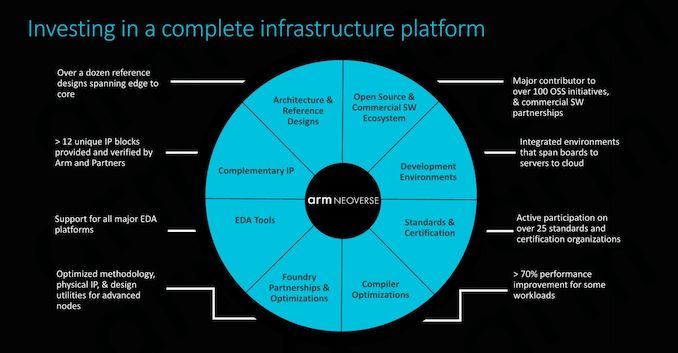Arm Announces Neoverse N1 & E1 Platforms & CPUs: Enabling A Huge Jump In Infrastructure Performance
by Andrei Frumusanu on February 20, 2019 9:00 AM ESTEnd Remarks: Strengthening the Infrastructure Ecosystem
If there’s one thing that readers should take away from today’s presentations, it’s the fact that Arm is taking the infrastructure and server push extremely seriously. The last year in particular has been transformative for the Arm ecosystem as we’ve for the first time seen Arm vendor platforms be competitive with the major incumbents such as Intel and AMD.
The elephant in the room is Amazon, and last year’s reveal of a new AWS instance based on their own-in house ARMv8 Graviton processors marked a significant moment showcasing that Arm is now irrefutably becoming mainstream in the industry.
While Arm did not divulge any information on who will be employing the new Neoverse N1 platforms first – I would not be surprised if the next generation Graviton processor will based on the N1 CPU.
The N1 CPU looks to be an excellent CPU that targets a sweet-spot point between peak compute performance, overall throughput. And most importantly it maintains the leading power efficiency that is already found in Arm's mobile products. Arm has high hopes for N1 and its eventual successors, and for good reason: they're looking to steal market share away from the likes of Intel (and x86 servers in general), which has proven to be an entrenched market full of very high performance processors. For that reason Arm is bringing their best to the table, and while N1 isn't going to be a core-for-core competitor with flagship x86, it stands to pose a significant threat, especially in workloads that can easily scale up to a larger number of cores.
Meanwhile the new E1 CPU targets the expanding market for high throughput processors, which with the upcoming shift to 5G will require more throughput performance at low power levels. Here Arm seems to have custom-tailored a CPU specifically to serve such use-cases. This is a move that's arguably less about stealing market share from any one player, and more about being in the right place at the right time to secure their place in what should be a rapidly growing market. In that sense the E1 is a very traditional Arm move – focus on cost and simpler processors – and this has been a move that's continued to serve Arm well over the years.
Although the new hardware IP is impressive, what also matters greatly is Arm’s efforts into strengthening the Arm software ecosystem. Working with various industry hardware and software partners in trying to facilitate the software stack and interoperability with Arm not only benefits vendors using Arm’s own hardware IP, but also vendors who chose the route of employing their own custom CPU and SoC designs. Similarly, those vendors who are trying to improve and strengthen their own products will inevitably feed back into strengthening the Arm ecosystem as well – creating essentially what is a group effort between many companies that in the future will continue to gain momentum.
It's said that the Neoverse N1 will be commercially deployed by partners in the next 12-18 months, and I think this will be a crucial moment for Arm and the company’s server endeavours. If the major breakthrough in mind-share hasn’t already happened, if all goes well and Arm and partners deliver on the promised improvements, the next 1-2 years will certainly represent a major shift in the industry.











101 Comments
View All Comments
Andrei Frumusanu - Wednesday, February 20, 2019 - link
> It also shows a result showing Zen roughly half the performance of IntelThe W-3175X was at 4.5GHz with the whole 38MB of L3 for the one thread, while the 7601 ran at a peak of 3.2GHz.
Meteor2 - Wednesday, February 20, 2019 - link
I wish you’d normalised for frequency!Andrei Frumusanu - Wednesday, February 20, 2019 - link
That's not the point of the article.ZolaIII - Wednesday, February 20, 2019 - link
Next time read twice before posting. AVX on integer benchmark really?Wilco1 - Wednesday, February 20, 2019 - link
Of course. Never heard of how SIMD hugely affects libquantum for example?Andrei Frumusanu - Wednesday, February 20, 2019 - link
AVX works on integer ...ZolaIII - Wednesday, February 20, 2019 - link
The era of general purpose core's being used for HPC is long time gone. While general purpose core's are hire to stay they will do that with modest number of core's per system, the real push is towards special purpose and multi purpose accelerators. FPGA's being put in the first row because their reprogrammable nature. The ARM actually have an edge over the CISC (X86) because it's simply more efficient which having stellar integer performance for the size of the core. If you look at the development bord it's very clear ARM is pushing into right direction.Meteor2 - Wednesday, February 20, 2019 - link
Kind of. But bottom line is the 20-odd codes used predominantly in the world still run best on general purpose CPUs. Bending software to work on specialised architectures is really hard.ZolaIII - Thursday, February 21, 2019 - link
On the FPGA you bend hardware. That's the whole idea.wumpus - Thursday, February 21, 2019 - link
HPC traditionally meant double precision FLOPS. AI work or similar might want FPGAs until GPUs are sufficiently ready for such things (then FPGA can't keep up).FPGAs are painfully slow at what they do, but can take an entirely new architecture on the fly. We saw that with cryptomining as things went CPU->GPU->FPGA->ASIC. And if you need a lot of multiply-accumulate (like most AI), don't expect anything between GPU and ASIC.